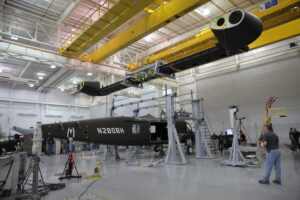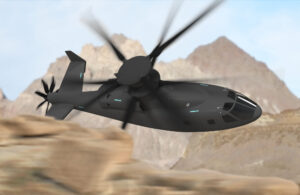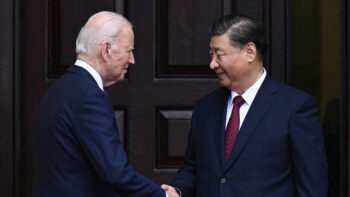
V-280 Valor wing mating at Bell Helicopter Amarillo
CORRECTED: 280 knots equals 322 mph, not 245.
Spring has sprung and at the Bell Helicopter factory in Amarillo, Texas, it’s mating season, of a sort. If all goes well, by September of next year a bird of a different feather will take flight – the V-280 Valor, a medium-lift tiltrotor transport whose wing and nacelles are being mated with its fuselage these spring days. Nacelles are pods that will hold the V-280’s two rotors and swivel them up to take off and land like a helicopter and forward to fly like an airplane.
“Last month (March) we affixed the nacelles to the wing,” said Vince Tobin, Bell vice president for advanced tiltrotor systems and V-280 program manager. “Earlier this month we got all that painted to match the fuselage. We have the wing in the fixture and it’s being prepared to be attached, wing to fuselage.” Wing and fuselage will be completely mated – wires, hydraulic lines and composite skins connected – by the end of April, just in time to announce that major stage during the Army Aviation Association of America’s 2016 Summit April 28-30 in Atlanta.
The V-280, which is much smaller than the V-22 Osprey tiltrotor transport built by Bell and Boeing Co., is Bell’s entry in the Army-led Joint Multi-Role Technology Demonstrator Program (JMR-TD), the first tangible product of the Defense Department’s Future Vertical Lift initiative. The FVL is to produce vertical takeoff and landing aircraft unhampered by the limited speed the aerodynamics of rotors impose on helicopters. The V-280 should cruise at 280 knots (about 322 mph), more than twice as fast as most helicopters.

Artist’s conception of SB>1 Defiant
Lockheed Martin Corp. subsidiary Sikorsky, partnered with Boeing, is building another JMR technology demonstrator based on Sikorsky’s X2, which in 2010 set an unofficial helicopter speed record of 290 mph. The Sikorsky-Boeing team expect to begin final assembly this summer of their SB>1 Defiant, a compound helicopter with coaxial rotors and a pusher propeller for greater speed. Both the Defiant and Bell’s Valor are to begin flight testing in 2017.
The companies hope the Army will choose their configuration as the basis for aircraft to replace the UH-60 Black Hawk and similar helicopters flown by other armed services. Bell’s V-280 “will be a color akin to what you would see Army aircraft painted, but that does not mean we are not readily amenable to painting other paint schemes on the aircraft,” said Tobin. “We are definitely looking to have those aircraft be in the Marine Corps and other services as well.”
The Army dropped out of the program that produced the V-22 soon after it began in 1982, and while the Osprey is flown by the Marine Corps, Air Force Special Operations Command and soon the Navy and Japan’s military, its high cost and some of its features have kept the Army uninterested. But Bell designed the V- 280 to rekindle the Army’s interest in tiltrotors.

Artist’s conception of Army V-280
Unlike the Osprey, whose wingtip nacelles swivel its engines along with its rotors, the Valor’s engines will be fixed horizontally on its wingtips. So when the V-280 sits on the ground with its rotors up, the engine exhaust won’t scorch ship decks or start grass fires, as V-22s have sometimes done. Fixing the V-280’s engines horizontally also allowed Bell to give the Valor side doors like a Black Hawk for troops to get in and out, rather than a rear ramp like the Osprey’s. Nor will the V-280 have the Osprey’s hurricane-force rotor downwash, for while the Valor’s maximum weight of 38,000 lbs. is far less than the V-22’s 52,600 lbs., the V-280’s rotors will be 35 feet in diameter, nearly as large as the Osprey’s 38-foot diameter rotors. With nearly as much rotor and far less to lift, the Valor’s “disk loading” — pounds of thrust per square foot of rotor disk area – will be about two-thirds that of the Osprey’s and the speed of its downwash correspondingly less.
With wing and fuselage mated, Tobin said, the next major physical feature to be added is the Valor’s tail, which will be shaped like a V rather than the Osprey’s H. By this time next year, Tobin expects the Valor’s avionics, flight control computers and two General Electric T64-GE-419 engines to be installed.
“That should set us up for a tethered ground run in April of next year, which will lead us to first flight in September of ’17,” Tobin said. “Right now we’re tracking to all of those dates.”
Taking aim: Army leaders ponder mix of precision munitions vs conventional
Three four-star US Army generals this week weighed in with their opinions about finding the right balance between conventional and high-tech munitions – but the answers aren’t easy.


























